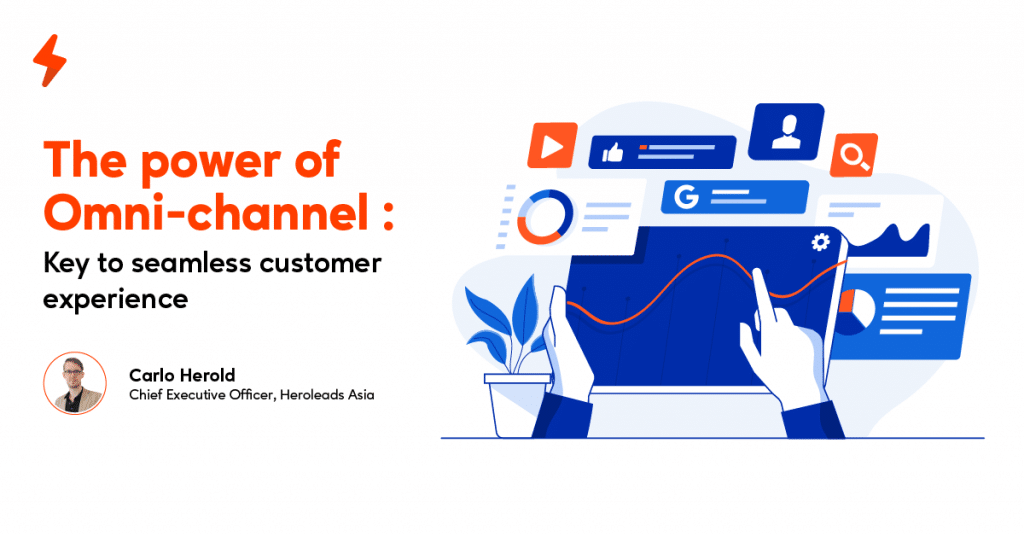The power of Omni-channel : Key to seamless customer experience

With the rise of the internet and mobile devices over the last decade, we’ve seen the emergence of a new type of consumer: the digital consumer. Now in 2020, with a global pandemic supercharging digitalization, the digital consumer has taken over. As a brand or company looking to be competitive in this environment, it is absolutely vital you adhere to the digital consumer’s needs.
For many of us who are digital consumers, we know we have started to unapologetically demand brands to offer us integrated “omni-channel” customer journeys; expecting them to seamlessly unite our offline and online experiences.
For example, as digital consumers we may spend the day on our smartphone interacting with mobile apps; switch to our tablets in the evening where we scan brand Facebook pages; and finally browse the brand’s website on our desktop computers on the weekend. We may end up purchasing a few items on any of these devices only to choose to pick them up at the store the next day.
Throughout this whole journey, we expect an unprecedented level of interconnection between sales and communication channels across all devices, and we are appalled when our expectations of interconnection are not met.
Indeed, based on a recent study by Facebook “Omni-channel comparison shopping is part of the consumer purchase journey. The purchase journey is rarely purely online or offline. Eighty-six percent of consumers surveyed compare products online, offline or both before making a purchase. About a third still check physical stores and other websites before buying.”
To ensure marketing, sales, and customer service are synchronized and integrated across all channels and devices, brands and companies must look towards omni-channel management.
Multi-, Cross- and Omni-channel: related but not identical
To understand omni-channel, it is important to distinguish it from the concepts of multi- and cross-channel. These three terms are often mistakenly used synonymously or are understood to represent the same idea. This is not surprising, since they are based on very similar concepts. The devil, however, lies in the details; and it’s in the little details that we can understand the nuanced but important difference between the three.
“Multichannel” describes the simple existence of several channels operated by a brand or company. If a website, a blog, and a Facebook page are maintained, the criterion for the multichannel approach is fulfilled. However, in a multi-channel approach, the individual channels are not yet connected. Rather, they exist independently from one another.
With a “Cross-channel” approach, the first integrations of sales channels start to take place. A classic example of a cross-channel approach is when a customer can order a product via the online shop and pick it up in store instead of waiting at home for the parcel to arrive.
The “Omni-channel” approach goes even a few steps further. Various channels are integrated, sometimes even merged, with a declared goal of enabling customers to communicate with the brand without media discontinuity. To facilitate this, it is essential that the customer can change channels at any time during the purchasing process without interruption. This requires the level of information on the brand’s side to be simultaneously and seamlessly transferred between channels.
For example, if a customer discussed his problem with the company’s customer service via phone and then switches to chat, he must be able to receive further advice without having to start from scratch. Similarly, if a customer has favored a product in the desktop version of the company’s website, the same product should also be accessible via the smartphone app, so that the customer can order the desired item directly from either device.
The channel concept here is very global: it refers both to different end devices (smartphone, tablet, desktop PC) and communication channels (e-mail, Line, Facebook Messenger, WhatsApp, telephone call, social media).
The core objective of this comprehensive interconnection between sales channels can be summed up briefly: flexibility. The customer is king and should be as free as possible in her shopping experience. But, flexibility also benefits brands: the fewer hurdles there are to overcome within the purchasing process, the more likely a purchase will be completed.
What is required to successfully implement goal-oriented omni-channel management?
1. Channel change – yes or no?
As described above, the core of the omni-channel approach is to allow customers to change channels at any time. However, the emphasis here is on the optional character. Because, as studies suggest, customers find a forced channel change annoying. In particular, the need to leave a specific sales channel (let’s say from phone to email) when problems arise is a source of displeasure and, in fact, leads to the company being perceived as rigid and not service-oriented. While concentrating on the potential of an omni-channel approach, it should always be possible to handle the entire purchase or service process through one channel.
2. Personalization
The fact that customers have autonomy over the channels they use is the foundation for this next essential factor. Customers want to go through personalized purchasing processes within which they are recognized as the same customers and which they can design themselves. In brick-and-mortar stores and on social media, this is far too often neglected. If a customer contacts a service employee via Facebook, for example, he or she should be able to get an immediate overview of previous purchases and the current purchase process thanks to access to central data. This is the only way for customers to feel like an individual and not a number.
Offering such personalized experiences across channels is exceptionally challenging. Even simply connecting digital channels remains difficult for most companies as digital sales often occur across multiple platforms (brand.com, marketplaces, and social commerce).
3. Interconnection between sales channels
For personalization to be technically possible, all channels must of course be connected with each other – this is the basic prerequisite for the Omni-channel principle. This also means that each channel must refer to the others. The various business units must also be connected: only if customer service has insight into the activities of the sales department can it effectively help customers. Overall, the analog-digital hurdle must be overcome. A product must not look significantly different online than in a store, and a product found on the Internet should also be available locally.
4. Uniformity
The omni-channel approach also calls for uniformity: customers must be able to find the same information via any channel. This applies to prices as well as to general product information or contact persons. However, this does not mean, for example, that interfaces should not be adapted to the respective end devices. On the contrary: only a mobile-optimized website can be used effectively from a smartphone.
5. CRM solutions
Synchronization and personalization across all channels requires that all data is stored and managed centrally. This demands a comprehensive customer relationship management tool that can be maintained and viewed across the company by marketing, sales and customer service.
A good example: Decathlon
The French sporting goods manufacturer Decathlon is one company that has successfully implemented an omni-channel approach, applying the above five factors. In Singapore, the company implemented the “Decathlon eXperience”, a kind of analogue online shop. There are no cashiers; instead, customers scan the items themselves and pay using the usual online payment methods. If desired, the purchases can then be delivered directly to the customer’s home.
Conversely, it is also possible to pick up the goods purchased from home at the store. Moreover, Decathlon is present on all conceivable platforms from Facebook to YouTube and is absolutely consistent across all channels.
Conclusion
In today’s world, an omni-channel approach is no longer a nice-to-have, it is a must-have. However, successfully implementing omni-channel management can be exceptionally complex. Brands and companies must first understand the foundations. Success is only possible if there is a strong collaboration between systems, technology and marketing.
At Heroleads, we’ve spent a significant amount of time understanding omni-channel management. We have a team of experts working with corporate clients to map out their full customer journeys and are dedicated to make sure we deliver on the elements required for successful omni-channel management.
Recent posts


